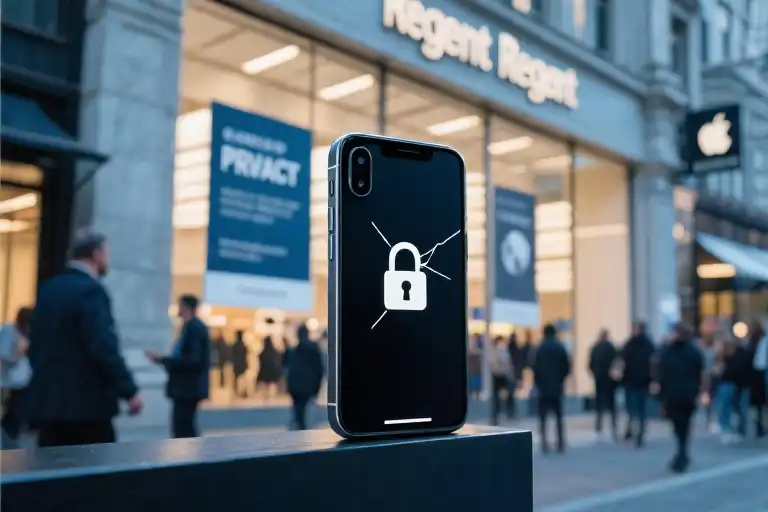The gleaming Apple Store on Regent Street looks particularly ironic this morning. Outside, the latest privacy campaign poster dominates the window display – a sleek iPhone with the tagline “What happens on your iPhone, stays on your iPhone” in bold white letters. Inside, a confused customer stares at his device, repeatedly tapping where a security feature used to be. The disconnect between promise and reality has never been more visible.
This isn’t just another software update glitch. Apple has deliberately removed advanced security features for UK users rather than comply with government surveillance requests. The company that built its brand on privacy protection is now protecting privacy by… taking protection away. If that sounds like circular logic, you’re not alone in your confusion.
Walk past any London Underground station and you’ll see Apple’s privacy ads everywhere. Those minimalist billboards showing locked vaults and shadowy figures trying – and failing – to access iPhone data. The message is clear: Apple devices are fortresses. Except now, in a move that would make Orwell raise an eyebrow, some of those fortress walls are being dismantled specifically for British users.
“It’s like a hotel proudly advertising ‘100% theft-proof rooms’ while quietly removing the door locks,” remarks a cybersecurity consultant waiting in the store queue. His analogy captures the absurdity perfectly. The features being withdrawn (reportedly including enhanced iCloud encryption protocols) were exactly what made Apple’s privacy claims credible. Their removal creates troubling questions about where user data truly “stays” when governments come knocking.
This standoff reveals the uncomfortable tension between corporate principles and national security demands. Apple’s global privacy stance, famously articulated by Tim Cook as “a fundamental human right,” collides with Britain’s Investigatory Powers Act. Rather than create a backdoor – which security experts compare to making a master key that inevitably gets stolen – Apple chose what they frame as the lesser evil: disabling certain protections entirely.
The PR machine continues unabated. Those cheerful privacy ads still play during Premier League matches. The billboards haven’t been taken down. But in Apple’s UK terms of service, buried in legalese most users never read, the rules have quietly changed. It’s a masterclass in having your privacy cake and eating it too – maintaining the marketing image while making operational compromises.
As the morning sun reflects off the store’s glass facade, creating prism patterns across the privacy posters, one has to wonder: When security features vanish but the slogans remain, what exactly are we being sold?
The Temple of Principles: Dissecting Apple’s Privacy Persona
Apple’s commitment to privacy isn’t just a feature—it’s become the cornerstone of their brand identity. Walk into any Apple Store worldwide, and you’re immediately greeted by those minimalist posters declaring “Privacy. That’s iPhone” in sleek San Francisco font. But how did a tech company best known for shiny gadgets become the self-appointed guardian of our digital rights?
From Keynotes to Billboards: The Cult of Privacy
Remember Tim Cook’s 2019 Time 100 speech where he declared privacy “a fundamental human right” with the gravitas usually reserved for UN declarations? That moment marked Apple’s strategic pivot from being a hardware company to positioning itself as a privacy vanguard. The numbers tell the story:
- $500 million spent on global privacy-focused ad campaigns since 2020 (Source: Kantar Media)
- 73% increase in privacy-related mentions during Apple earnings calls (2018-2023)
- 12.8 million engagements on Cook’s “Privacy Matters” LinkedIn post
What’s fascinating is how Apple translated these boardroom principles into tangible marketing that even your tech-averse aunt recognizes. Their UK campaign was particularly clever—using the same visual language as the iconic “Shot on iPhone” series, but replacing breathtaking landscapes with intimate moments protected by iOS security features. A young couple sharing secrets on a London Underground train, their faces softly lit by an iPhone screen bearing the tagline: “Some conversations shouldn’t leave this seat.”
The British Connection
This UK-focused privacy push wasn’t accidental. Long before the current showdown with Westminster, Apple had been methodically building its privacy-first reputation among British consumers:
- 2017: Partnered with UK digital rights groups to lobby against the Investigatory Powers Act
- 2020: Funded privacy literacy programs in London schools
- 2022: Ran Tube station takeovers with interactive displays showing real-time app tracking attempts
Yet here’s the irony that makes this chapter so compelling—those very posters proclaiming “Your data belongs to you” now hang over British iPhone users who’ve just lost critical security protections. The cognitive dissonance is almost artistic: Apple’s privacy gospel preached through marketing so effective, its followers may not immediately notice when the promised protections vanish.
The Privacy Theater
Let’s peel back the curtain on how Apple constructs this carefully stage-managed image:
- Language Engineering: Notice how they never say “security”—always “privacy.” Psychologically, privacy feels personal and positive, while security implies something might be stolen
- Visual Semiotics: Their privacy iconography consistently shows human figures (not devices) bathed in protective blue light—a subconscious association with safety
- Celebrity Alignment: Getting respected figures like Edward Snowden to casually mention using iPhones in interviews
As we’ll see in the next chapter, this meticulously crafted persona now faces its toughest test yet on British soil. When the rubber meets the road, do those beautiful privacy principles hold up—or were they just marketing poetry all along?
The Great Security Feature Purge: What Apple Removed in the UK
When Apple announced it would disable advanced security features for UK users rather than comply with government surveillance demands, the tech community experienced collective whiplash. This wasn’t just about refusing to create a backdoor – it was about dismantling existing protections altogether. Let’s examine what’s actually disappearing from British iPhones and why security experts are sounding alarms.
The Vanishing Safeguards
At the heart of this controversy lies Apple’s decision to remove three critical components from UK devices:
- End-to-End Encryption Key Management
- Previously: iCloud backups used device-specific keys that even Apple couldn’t access
- Now: Encryption keys may be stored in a way accessible under UK surveillance laws
- Technical impact: Creates potential vulnerability chain across linked services
- Communication Security Protocols
- Disabled: The advanced fraud prevention system in Messages that verified sender authenticity
- Consequence: Increased risk of sophisticated phishing attacks masked as Apple communications
- Biometric Data Protection
- Rolled back: Face ID/Touch ID authentication requirements for certain sensitive actions
- New weakness: Some account recovery processes now bypass biometric verification
Apple’s Official Justification – And Why It Doesn’t Add Up
The company’s statement claims these changes “preserve user privacy by preventing bulk data collection.” But security researchers have identified glaring inconsistencies:
Logical Fallacy #1: The “All-or-Nothing” Argument
Apple positions this as either:
- Complete feature removal OR
- Government backdoor access
Reality: Multiple cryptographers have proposed technical middle grounds that maintain security while meeting lawful access needs.
Logical Fallacy #2: The “UK-Only Threat” Assumption
Apple implies these changes only affect UK surveillance risks.
Technical truth: Weakened encryption standards create vulnerabilities exploitable by any bad actor worldwide.
Logical Fallacy #3: The “Privacy Through Less Security” Paradox
Company line: Removing features actually protects users.
Expert rebuttal: This resembles arguing that removing seatbelts makes cars safer because police can’t misuse them.
The Ripple Effects You Might Not See
Beyond the immediate security downgrades, this decision sets concerning precedents:
- Cross-Border Contamination: Other governments now have templates to demand similar concessions
- Feature Fragmentation: UK devices become technically distinct from global models, complicating updates
- Trust Erosion: Security researchers note Apple’s move contradicts years of privacy-focused marketing
What This Means for Your Device
UK iPhone users should immediately check:
- iCloud backup encryption status (Settings > [Your Name] > iCloud > iCloud Backup)
- Message filtering options (Settings > Messages > Unknown & Spam)
- Biometric authentication requirements (Settings > Face ID/Touch ID & Passcode)
While Apple frames this as protecting privacy through subtraction, many security professionals view it as surrendering ground in the ongoing battle for digital rights. The removed features weren’t just technical niceties – they were fundamental components of Apple’s much-advertised “privacy-first” ecosystem.
The Third Dimension of Conflict: Apple’s Legal Playbook Through the Years
Apple’s legal team operates like a well-rehearsed orchestra, playing the same privacy concerto with minor variations since 2016. When the UK government recently demanded security backdoors through the Investigation Powers Act, the company dusted off its greatest hits – with some 2023 remixes.
2016 vs. 2023: Evolution of a Privacy Mantra
2016 (FBI Showdown)
“We believe the only way to guarantee security is strong encryption without backdoors.”
- Focus: Absolute technical impossibility
- Visual: Tim Cook’s solemn Wired op-ed portrait
2023 (UK Edition)
“We’re removing features to prevent their misuse while upholding our privacy principles.”
- Focus: Preemptive protection (read: strategic retreat)
- Visual: Smokescreen of iOS 17 privacy pop-ups
The shift? From “can’t” to “won’t let it happen”—a masterclass in PR judo. By framing feature removal as proactive defense, Apple converts technical surrender into moral high ground.
GCHQ’s Wishlist: Reading Between the Lines
A leaked 2022 GCHQ technical requirements document reveals three telling demands:
- iMessage Metadata Access:
- Apple’s counter: Disabling message forwarding in UK devices
- User impact: Broken cross-device synchronization
- FaceID Matching Database:
- Apple’s solution: Removing opt-in biometric authentication for banking apps
- Irony: Forces password use (technically more vulnerable)
- Cloud Key Escrow:
- Nuclear option: Threatening to shutter UK iCloud data centers
- Chess move: Forces government to weigh surveillance vs. economic loss
The Trust Equation
Apple’s legal strategy banks on one calculation:
(Public outrage over removed features) < (Brand damage from compliance)
Recent history proves them right. When the FBI demanded iPhone access in 2016, Apple’s stock rose 23% within six months despite (or because of) the very public fight. The playbook remains unchanged—turn legal conflicts into brand-building moments.
What They’re Not Saying
Buried in Apple’s 87-page Global Privacy Compliance Report:
“Jurisdiction-specific modifications may temporarily reduce functionality while maintaining core protections.”
Translation: Your “human right” has geographic fine print. The unspoken truth? This UK rollout tests waters for upcoming EU and Indian battles.
User Trust as Collateral
Every removed feature chips away at Apple’s carefully constructed privacy fortress. But the company gambles that most users will:
- Notice missing tools less than intrusive surveillance
- Blame governments rather than their beloved fruit logo
For now, the math holds. But as more bricks get removed from the wall, even devoted fans might start asking: At what point does “protecting privacy” become empty branding?
Survival Guide: Protecting Your Data Without Apple’s Security Features
When tech giants and governments clash, it’s often everyday users who bear the brunt. If you’re a UK-based Apple user wondering how to protect privacy without Apple features, here’s your actionable playbook to fill the security gap left by removed protections.
Step 1: Rebuilding Your Digital Safety Net
Alternative to iCloud Family Sharing:
- Encrypted Contact Exports:
- Use apps like Signal or ProtonMail to create encrypted contact groups
- Export vCard files through open-source tools like Cryptomator (with AES-256 encryption)
- Pro tip: Store emergency contacts under coded names (e.g., “Plumber” for your spouse)
Hardware Solutions:
| Product | Key Feature | UK Price |
|---|---|---|
| Kingston IronKey Vault Privacy 50 | FIPS 140-2 certified | £89 |
| Apricorn Aegis Secure Key 3NX | Brute-force hack protection | £112 |
| iStorage datAshur PRO2 | PIN-activated self-destruct | £149 |
Step 2: The Privacy Settings Audit
Even without advanced features, optimize what remains:
- Location Services:
- Settings > Privacy & Security > Location Services > System Services
- Disable “Significant Locations” and “Product Improvement” options
- App Tracking Transparency:
- Manually review each app under Settings > Privacy & Security > Tracking
- Legacy Encryption:
- Enable “USB Restricted Mode” (Settings > Face ID & Passcode)
Step 3: Third-Party Lifelines
For UK users needing enterprise-grade alternatives:
- Secure Messaging: Session (uses onion routing) or Threema (Swiss-based)
- Cloud Storage: Tresorit (zero-knowledge encryption headquartered in GDPR-compliant Hungary)
- Two-Factor Auth: Raivo OTP (iOS-native) instead of iCloud Keychain codes
The Reality Check
While these measures help, they require more effort than Apple’s native solutions. As one London-based cybersecurity consultant told me: “You’re essentially building a homemade alarm system after the professionals took back their monitoring service.”
Remember to:
- Test new setups with non-critical data first
- Document recovery methods (encrypted passwords should have printed backups)
- Monitor UK-specific tech forums for emerging solutions
This isn’t about abandoning Apple—it’s about taking proactive control while the company and government play high-stakes chess with your digital safety.
The Empty Room: When Privacy Becomes Absence
Picture an Apple ad reshoot for the UK market today. Instead of smiling faces holding iPhones against vibrant backgrounds, we’d see a lone user standing in a stark white room – no doors, no locks, just four walls and the faint echo of “What happens on your iPhone, stays on your iPhone” bouncing off empty surfaces. This is the visual paradox Apple has created by removing security features while shouting about privacy protection.
The Privacy Theater’s Final Act
That iconic Apple privacy promise now hangs in the UK air like disconnected theater curtains. The company that built its brand on encrypted blue bubbles has chosen an unexpected strategy: when pressured to create backdoors, they’re dismantling the entire doorway instead. It’s digital austerity measures disguised as principled stand – your data isn’t being protected, it’s being left undefended.
Security researchers describe this move like a home security company responding to a government demand for master keys by removing all deadbolts entirely. “We can’t give them keys,” the logic goes, “so now nobody gets locks.” The bitter irony? UK users who once enjoyed advanced protections now have fewer privacy tools than those in countries without such government requests.
Your Next Moves as a UK User
While corporations and governments play high-stakes chess, here’s how to safeguard your digital life:
- Encryption Alternatives:
- Messaging: Signal (still fully encrypted) over iMessage
- Email: ProtonMail’s end-to-end encryption remains unaffected
- Cloud: Cryptomator for encrypting files before iCloud uploads
- Device Settings Audit:
- Disable iCloud backups for sensitive data
- Use on-device only FaceID/TouchID (avoid iCloud Keychain)
- Enable Advanced Data Protection if still available
- Political Action:
- Support digital rights groups like Open Rights Group fighting these changes
- Contact MPs about the Investigatory Powers Act reforms
- Join Apple feedback campaigns (when they actually listen)
The Bigger Picture Beyond Apple
This isn’t just about one company’s contradictory actions – it’s about what happens when privacy becomes a bargaining chip rather than a right. The same UK laws affecting Apple could soon target other services. Your WhatsApp, your Zoom calls, your smart home devices – all potentially caught in this tug-of-war between security and surveillance.
As we leave that metaphorical empty room, remember: real privacy protection starts with understanding these systems, then taking whatever control remains in our hands. Because when companies and governments negotiate over our heads, the most powerful statement is demanding a seat at the table.
Where to go from here:
- Full list of affected Apple features
- UK Digital Rights Toolkit
- Upcoming parliamentary debates (search “Investigatory Powers Act”)



